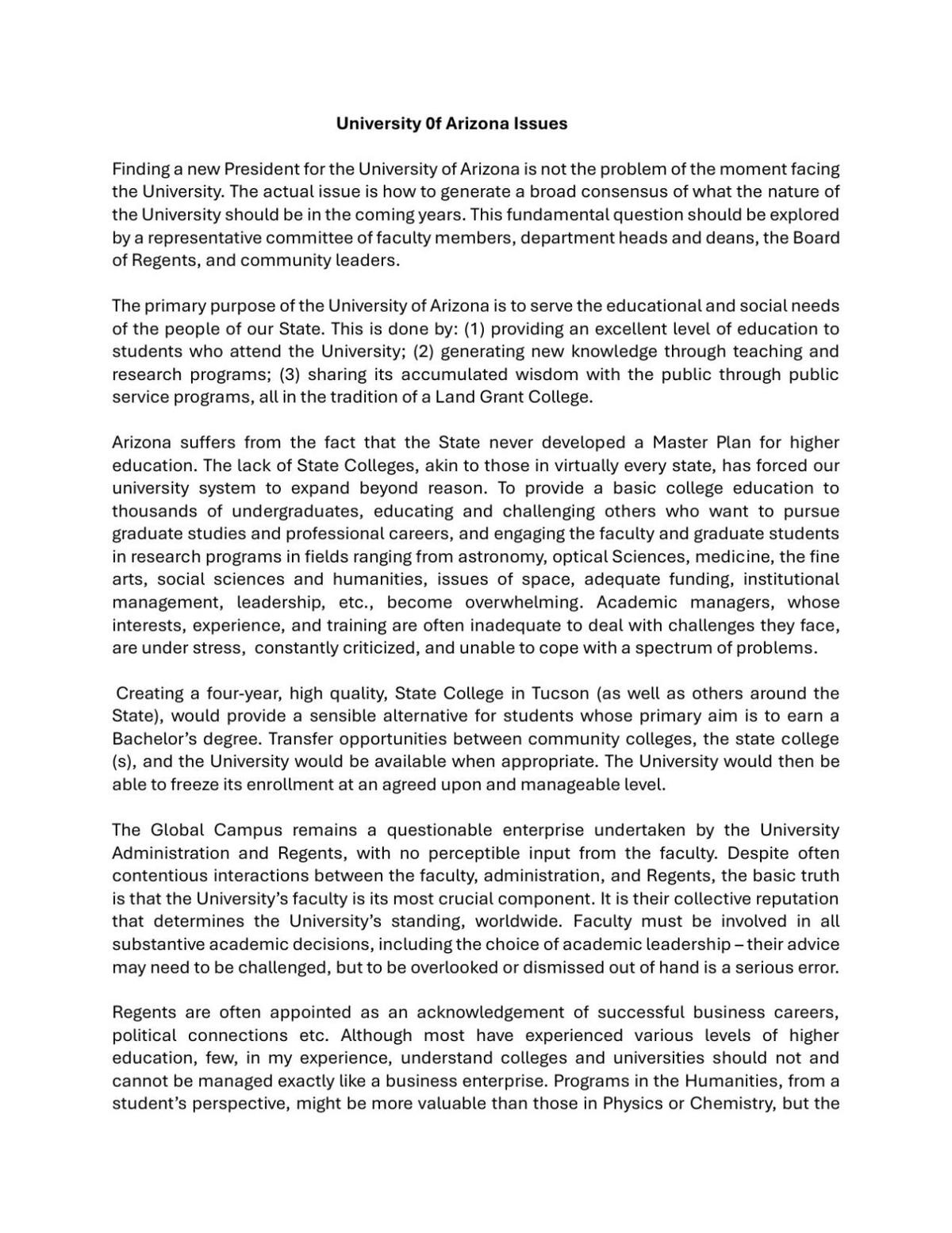The University of Arizona should halt its provost search and disclose more details about its controversial UA Global Campus, the university’s President Emeritus John P. Schaefer says in his first statement about the UA’s financial troubles.
“The global campus issue remains divisive and must be resolved now, with details of prior negotiations made fully public,” Schaefer said of the university’s acquisition of a formerly for-profit online school accused of cheating students before UA owned it. “If deemed to have negative implications for the reputation and well-being of the university, divestiture must be pursued.”
He also criticized the state of public education in Arizona, suggested creating a four-year state college in Tucson and freezing UA’s enrollment levels, and pushed back against decisions of the Arizona Board of Regents.
Schaefer became the 15th president of the university in 1971, and its second-youngest in history, serving through 1982. He accelerated development of Lunar & Planetary Sciences and astronomy and is credited with building UA’s reputation as a research university and one of Tucson’s largest employers. He played a major role in creating the Pac 10 conference and founded the UA’s Center for Creative Photography with Ansel Adams. He is also a former CEO and president of the Research Corp. for Science Advancement.
His public statement was released Thursday afternoon, during UA Interim Chief Financial Officer John Arnold’s presentation to ABOR. Arnold reported that the university’s projected deficit for next fiscal year has been cut to an estimated $52 million, down from $162 million.
The day before, the regents formally began a search for UA’s next president, after President Robert C. Robbins announced earlier this month that he will step down by June 2026.
The transitions, Schaefer wrote, come when the university is at a crossroads.
“Finding a new president for the University of Arizona is not the problem of the moment facing the university,” he wrote. “The actual issue is how to generate a broad consensus of what the nature of the university should be in coming years.”
Hire president before provost
Though it is close to concluding, Schaefer said the search for the UA’s next provost, or leader of the academic units, should be paused.
“The recruiting of a provost should be halted until a new president is appointed,” he said. “You do not hire the vice-president of a company before you hire the president!”

John P. Schaefer shown when he was University of Arizona president.
Currently, the search is down to two candidates: Marie Hardin, dean of the College of Communication at Pennsylvania State University; and Joseph Glover, former provost of the University of Florida. The third finalist, Fouad Abd-El-Khalick, withdrew in order to become provost of the University of Massachusetts Amherst.
Questioning the regents
Regents, who oversee the state’s three public universities, “are often appointed as an acknowledgement of successful business careers, political connections etc.,” Schaefer noted.
"Although most have experienced various levels of higher education, few, in my experience, understand colleges and universities should not and cannot be managed exactly like a business enterprise,” he wrote.
Throughout the UA’s financial crisis, revealed in November, university leaders have discussed the president’s role as that of a CEO and referred to the UA in business-like terms.
“Having served as president of the University of Arizona, a trustee of a private university, an Arizona private school board member and a director on the boards of several companies listed on the New York Stock Exchange, I know how different each of these organizations are and how vital it is to receive appropriate orientation before you can contribute effectively to the enterprise,” Schaefer wrote. “We need to do a better job of educating and orienting our leaders.”
Schaefer also cautioned that regents may not understand the need to fund certain programs, like those in the humanities, for example, over STEM fields that are more likely to bring in grant money.
“Some disciplines attract generous external funding from foundations or federal programs while others rarely are on the receiving end of a gift — yet to a student, both are equally important,” Schaefer said.
UA Global Campus
Since UA acquired it in 2020, the former Ashford University, an online school that has been revamped as UA Global Campus, has been mired in controversy.
The Biden administration cancelled $72 million in student loans for borrowers who say they were cheated by Ashford. The U.S. Department of Education is seeking to recoup the money from the UA, which says it should not be held responsible because the actions occurred well before it acquired the school.
UA interim CFO Arnold told the regents Thursday that UAGC will soon bring in a profit.
But, according to Schaefer, the project “remains a questionable enterprise” that did not have “perceptible input from the faculty.”
The faculty, he said, need to be more involved in university affairs.
“Faculty must be involved in all substantive academic decisions, including the choice of academic leadership,” he wrote. “Their advice may need to be challenged, but to be overlooked or dismissed out of hand is a serious error.”
He also wrote that the role of athletics needs to be reviewed because “when NIL payments exceed the salaries of professors, something is clearly amiss.” NIL refers to name, image and likeness, a way college athletes can receive compensation through marketing and promotions.
A new state college?
“Arizona suffers from the fact that the state never developed a Master Plan for higher education,” Schaefer wrote. “The lack of state colleges, akin to those in virtually every state, has forced our university system to expand beyond reason.”
To fix that, Schaefer said, the state should consider opening a “four-year, high quality” state college in Tucson that “would provide a sensible alternative for students whose primary aim is to earn a Bachelor’s degree.”
Bigger universities like the UA, then, would be able to freeze their enrollments at a “manageable” level.
In 2023, there were 40,533 undergraduate students compared to 30,665 in 2011. Graduate student enrollment has also increased — in 2011 there were 7,083 graduate students at the university, and in 2023 there were 11,112.
Combining students at Arizona Online, Arizona International and the satellite campuses across the state, the total enrollment in 2023 was 53,187.
“Seriously planning of the need to limit enrollment should be initiated with a parallel study of its financial implications,” he wrote.
It would be surprising if the state government chose to fund the creation of new public colleges. During the Great Recession in 2008, the state slashed funding for its public universities.
When adjusted for inflation, Arizona spending per student in the state decreased by 54.3%. That was the highest drop in the United States, according to a report by the Center on Budget and Policy Priorities.
Get your morning recap of today's local news and read the full stories here: tucne.ws/morning






